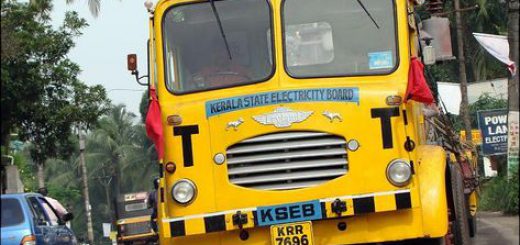Logistics is one of the most complex industries and yet plays a pivotal role in the economic growth of any country. Not just that, having a robust logistics and supply chain mechanism in place is essential for the success of other industries. In the last few years, the world of logistics and transportation has undergone a significant transformation, largely driven by technological advancements. One of the areas which is constantly evolving is tracking of consignments right from the source to the destination.
Why is tracking important?
In today’s uncertain global economic scenario where disruptions have become the order of the day, it is important to have complete visibility of the entire supply chain. With the rise of global trade and the increasing complexity of supply chains, it is essential for businesses to have visibility into their operations to ensure that they are able to deliver goods and services to their customers in a timely and efficient manner. This can be achieved through tracking of the consignment right from the source till it reaches the destination.
According to industry experts, it is critical for a supply chain manager to know about the shipment’s location, the estimated time of arrival (ETA), and any possible disruption or current and past status of the shipment to manage and control their fleet, orders, and goods. Thus, tracking is essential as it provides real-time visibility into the movement of assets, ensuring their security and safety in potentially volatile regions. This can help them to identify bottlenecks or delays, and take corrective action to ensure that their operations are running smoothly.
Additionally, it aids in risk mitigation by allowing organisations to adjust routes and schedules in response to geopolitical developments, such as trade disputes or border closures, minimising potential disruptions and losses. For example, if a shipment is delayed at a port due to a customs issue, a business can use tracking information to quickly identify the problem and work with the relevant authorities to resolve it.
“Tracking is one of the most crucial aspects in the supply chain ecosystem. In the chemical industry, it becomes even important to have an efficient tracking mechanism in place to avoid mishaps. We, at Indofill, use GPS tracking for our full truckload shipments, particularly for high-value goods moving between plants and warehouses. However, there’s no central tracking system. We obtain tracking information from our third-party logistics providers (TPLs) or platforms. This data is crucial for ensuring shipment safety, managing incidents like accidents or pilferage, and providing real-time visibility to our sales teams when needed,” Sandeep Baxla, Sr Vice President Supply Chain, Indofill, said.
Advantages of tracking
Tracking and tracing is a vital part of logistics and supply chain management. It helps businesses to ensure that their products are properly accounted for at every stage of the shipping process and can help reduce losses due to damage or theft. Here are a few advantages of tracking:
Real-time visibility
One of the primary advantages of consignment tracking is the unprecedented visibility it provides into the supply chain. Logistic companies can now monitor the exact location of shipments, the route taken, and estimated arrival times. This visibility allows for better planning, improved resource allocation, and efficient problem-solving in case of delays or disruptions.
“According to the report published by Forbes and KPMG International, lack of visibility across the extended supply chain is one of the biggest challenges for companies. Therefore, track and trace in logistics are essential to increase transparency across every step of the supply chain. The current technological advancements have enabled manufacturing sites, e-commerce businesses, and warehouses to track and trace shipments over their complete life cycle,” JP Mishra, Country Manager India, Newland AIDC, said.
Improved customer experience
Consignment tracking has become an essential tool for enhancing customer experience. Real-time updates on shipment status enable companies to provide accurate delivery estimates, reducing customer anxiety and frustration. Customers can also proactively manage their inventory and distribution, leading to higher satisfaction levels.
“A robust tracking system instils trust – the bedrock of any lasting relationship. This trust ensures drivers, stakeholders, and customers are always on the same page, eliminating the guesswork and ensuring seamless operations. In a nutshell, tracking and tracing fortify the supply chain against disruptions, making it resilient, reliable, and ready for tomorrow’s challenges,” Nishith Rastogi, CEO and Founder, Locus said.
Increased security
Tracking technology has significantly increased the security of consignments. Companies can monitor shipments for potential theft or tampering, and the ability to pinpoint the exact location of goods helps in deterring theft and recovering stolen items. This added layer of security boosts confidence in the transportation of valuable or sensitive goods.
Besides, it also ensures safety of drivers carrying the goods from one location to another. “While everything boils down to cargo safety, it is important to provide vehicle safety and driver safety to ensure that the consignment safely reaches its destination. Initially, when the GPS was introduced, there was a resistance from the driver community. But later, as they realised the benefits of it, especially during any incident or calamity, it has been widely accepted. Thus, tracking not only helps in safety of consignment, but has improved the working conditions for drivers,” Ramesh Kumar, an industry veteran who has been working for the welfare of the drivers said.

Efficient resource management
Tracking consignments facilitates optimisation of resources such as vehicles, labour, and fuel. Companies can analyse data collected from tracking systems to make informed decisions about route planning, load distribution, and maintenance schedules. This results in reduced operational costs and a more sustainable logistics operation.
“Tracking system has evolved from GPS to ultrahigh frequency systems, which is similar to FASTags. These devices are used for tracking and managing assets, inventory, or products. Operating within the UHF spectrum, typically around 860-960 MHz, these tags offer distinct advantages in asset tracking and inventory management. Due to their high-frequency range, UHF tags enable long-range reading, often up to several meters, making them exceptionally suited for applications where rapid and non-contact data capture is essential,” Ravindran Natarajan, Former Director, Business Development, Trimble, said.
He further said that using UHF streamlines inventory checks, reduces errors, and expedites the unloading process. “In fleet management, UHF tags helps in tracking vehicles, optimising routes, and ensuring compliance with schedules and regulations. This technology enhances operational control, minimises idle time, and boosts fuel efficiency. This ultimately leads to cost savings, improved accuracy, and timely deliveries, benefiting both businesses and customers,” Natarajan added.
Proactive issue resolution
Consignment tracking allows companies to identify issues and bottlenecks in the supply chain in real-time. This proactive approach to problem-solving minimises disruptions and reduces the impact of unexpected events, such as weather-related delays or accidents.
“Staying informed about inventory levels throughout the supply chain strengthens inventory management and planning. With the help of track and trace, we can improve our inventory management and reduce the time it takes to locate goods and perform manual inventory checks. In this way, employees can perform other essential tasks,” Rastogi added.
Role of control towers in tracking
Control towers are emerging as indispensable tools for 3PLs and businesses. Beyond tracking goods, they facilitate real-time inventory management, optimising stock levels and reducing carrying costs. Their predictive analytics capabilities foresee disruptions in the supply chain, allowing proactive measures to minimise risks.
Decision-makers can access comprehensive, up-to-the-minute data through these control towers, enabling quick, informed responses to issues like weather events or transportation bottlenecks. This agility enhances customer service and cost-efficiency. In an era where supply chain resilience is paramount, control towers are the linchpin, equipping 3PLs and businesses with the foresight and control needed to thrive in dynamic markets.
However, these control towers need to be integrated with various businesses such as warehousing, transportation – primary or secondary, distribution. “Control towers help in providing visibility to our customers about the movement of the inventory as well as the fleet. However, there are certain semi-automated processes which have to be aligned to a control tower which help in identifying the vehicle which has to be deployed to ensure optimum utilisation of the vehicle, route planning, road planning, etc.,” Karan Vir Puri, CSO, ProConnect Supply Chain Solutions, said.
Challenges in consignment tracking
While tracking and tracing have many benefits, there are also several challenges that need to be addressed in order to fully realise their potential. Here are a few challenges:
Cost
One of the main challenges of using supply chain track and trace is the cost. This system requires a significant investment in hardware and software, which can be expensive for some businesses.
Process delay
Among the challenges in logistics, process delays are a prominent issue. These delays stem from tracking systems encountering errors or lag, disrupting operations and potentially affecting customer satisfaction and delivery schedules.
Labelling constraints
Another issue that the industry is currently grappling with is labelling constraints. Errors or constraints in labelling can lead to misidentification, shipment rerouting, and delays. Proper labelling is paramount for accurate tracking and streamlined operations, making it a standout concern in the realm of logistics challenges.
Relative nature of supply chain vendors
The relative nature of supply chain vendors is a distinctive challenge in logistics tracking. It arises from the diversity of vendors, each with unique tracking systems and data formats. This fragmentation can impede seamless tracking and necessitate complex integration efforts, making it a standout concern in the logistics industry.
Data privacy and security
With the increase in data collection, there is a growing concern about the privacy and security of consignment tracking data. Companies have to ensure that customer and shipment data is protected from potential breaches or misuse.
Regulatory compliance
Different regions and industries have specific regulations regarding the tracking of consignments, especially for hazardous or sensitive materials. Companies must stay up-to-date with these regulations to avoid legal issues and penalties.
Need for technology improvements
Even today, a large number of businesses depend on GPS system for tracking goods. This is largely because many businesses have made it mandatory for fleet owners/ operators to deploy only GPS-enabled vehicles. Small businesses, which have limited exposure to latest technologies, are relying on 3PLs or local transporters with minimal access to tracking.
According to a study by Here Technologies, the pandemic has exposed the vulnerabilities of manual interventions in the global supply chain. Yet, a significant number of Indian logistics firms surveyed are using asset tracking and shipment monitoring software in combination with manual inputs to track assets, shipment, and cargo.
Manual processes have a higher chance of creating gaps and vulnerabilities within supply chains, and this shows that a large number of companies still do not have a resilient infrastructure in place. Real-time and automated tracking solutions on the other hand provide opportunities to accelerate innovation and tackle disruptions promptly, it stated.
Given the growing uncertainties and introduction of newer technologies coming in, it is important that tracking and tracing evolves. Newer technologies such as IoT, AI, robotics, warehouse automation, and Blockchain are the top five most promising technologies that are boosting innovation in logistics.
According to experts, adopting advanced technologies such as Blockchain, Big Data, cloud computing, and digital twins can help transform the future of the Indian logistics sector.
“Using AI, businesses can proactively and continuously analyse logistics KPIs. When it comes to tracking consignments, AI empowers logistics stakeholders to accurately identify if a consignment will breach the committed SLA and also access auto-generated historical-data-powered corrective measures. This helps businesses safeguard customer experience, reduce the chances of logistics failures from occurring and ensure rapid resolution of logistics issues,” Soham Chokshi, CEO & Co-founder, Shipsy, said.
He further stated that AI-powered route optimisation is critical to reducing logistics costs, especially in the middle and last mile. “It auto-allocates orders to riders and logistics partners based on business requirements like ‘most economical’ and ‘fastest.’ It ensures that more tasks are completed in a single journey without compromising SLA commitments. Then, using AI-driven territory and workforce optimisation, businesses can accurately determine the right mix of freelance and full-time couriers needed to achieve high levels of cost-efficiency without impacting the customer experience.”
Echoing similar views, V Rajesh Gowrinath , Senior Vice President – Sales, Gati, observed that tracking is a cornerstone of modern supply chains as it provides transparency, builds trust with customers, and streamlines our operations. “By monitoring shipments from pickup to delivery, we can swiftly address issues as they arise. We rely on technologies like GPS and transportation management systems (TMS) to boost efficiency and reduce costs. GPS enables precise tracking, while TMS optimises planning and execution across different transportation modes,” he said.
Gowrinath further stated that new technologies are helping in improving load planning and route optimisation and making the operations more efficient and intelligent. IoT and blockchain hold promise for the tracking industry in the future. With real-time information, security, and dependability in supply chain management, these technologies are ready to provide comprehensive solutions.
Conclusion
The logistics sector has been in the spotlight since the Covid-19 pandemic, and it is expected to grow significantly in the coming years. Consignment tracking has become a cornerstone of modern logistics and transportation, offering a wide array of benefits that positively impact efficiency, customer satisfaction, and security. However, it also poses challenges related to initial costs, data security, and regulatory compliance. To fully leverage the advantages of consignment tracking while mitigating these challenges, companies must invest in robust systems, prioritise data protection, and stay informed about evolving regulations. In doing so, they can create a more efficient and seamless transportation network that benefits both businesses and consumers alike.
Read more at-https://shorturl.at/rKMNP





Recent Comments